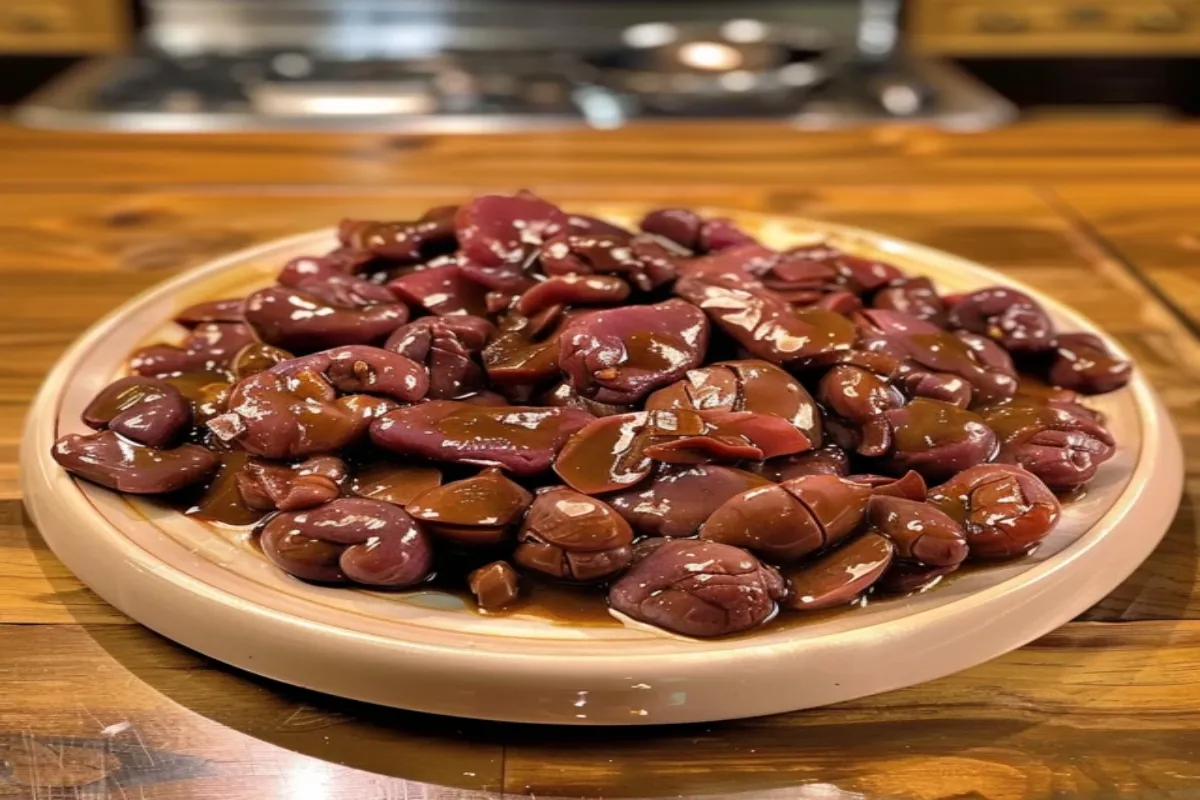Beef kidney is a nutrient-dense organ meat that has been a staple in various cuisines worldwide. Rich in essential vitamins and minerals, it offers numerous health benefits and can be prepared in diverse and flavorful ways. This article delves into the nutritional profile of beef kidney, its health advantages, methods of preparation, and culinary uses.
Introduction
Beef kidney is an organ meat derived from cattle, known for its rich nutrient content and distinctive flavor. Historically, it has been a valued component in traditional diets across the globe, appreciated for both its health benefits and culinary versatility. Despite its decline in popularity in modern Western diets, beef kidney remains a significant source of essential nutrients and offers a unique gastronomic experience.
1. Nutritional Profile of Beef Kidney
Beef kidney is a powerhouse of nutrients, providing a wide array of vitamins, minerals, and proteins essential for maintaining optimal health.
1.1 Macronutrient Composition
A 100-gram serving of cooked beef kidney contains approximately:
- Calories: 135 kcal
- Protein: 20.4 grams
- Fat: 3.1 grams
- Carbohydrates: 0 grams
This composition makes beef kidney a lean source of high-quality protein with minimal fat content.
1.2 Vitamin Content
Beef kidney is particularly rich in:
- Vitamin B12: 1146% of the Recommended Daily Value (RDV)
- Riboflavin (Vitamin B2): 168% of the RDV
- Vitamin B6: 52% of the RDV
- Vitamin A: 47% of the RDV
These vitamins play crucial roles in energy production, red blood cell formation, and maintaining healthy vision and skin.
1.3 Mineral Content
Key minerals found in beef kidney include:
- Iron: 58% of the RDV
- Selenium: 202% of the RDV
- Zinc: 13% of the RDV
- Copper: 22% of the RDV
These minerals are vital for immune function, antioxidant defense, and oxygen transport within the body.
2. Health Benefits of Consuming Beef Kidney
Incorporating beef kidney into the diet can offer several health advantages due to its rich nutrient profile.
2.1 High-Quality Protein Source
The high protein content in beef kidney supports muscle growth, tissue repair, and overall bodily functions.
2.2 Rich in B Vitamins
The abundance of B vitamins, especially B12 and B2, aids in energy metabolism and the maintenance of neurological health.
2.3 Excellent Source of Selenium
Selenium acts as a potent antioxidant, protecting cells from damage and supporting thyroid function.
2.4 Supports Immune Function
The presence of zinc and iron enhances immune responses and helps prevent anemia.
2.5 Contains Unique Compounds
Beef kidney contains L-ergothioneine, an amino acid that may promote kidney health and has antioxidant properties.
3. Selecting and Preparing Beef Kidney
Proper selection and preparation are crucial to maximize the flavor and nutritional benefits of beef kidney.
3.1 Selecting Quality Beef Kidney
- Source: Opt for kidneys from grass-fed, organically raised cattle to ensure higher nutrient quality and fewer contaminants.
- Freshness: Choose kidneys that are firm, moist, and have a fresh smell. Avoid any with a strong, unpleasant odor, as this indicates spoilage.
3.2 Cleaning and Prepping
- Trimming: Remove any visible fat, membranes, and the central white core to reduce any potential bitterness.
- Soaking: To mellow the flavor, soak the kidney pieces in milk or a saltwater solution for 1-2 hours before cooking. This process helps to tenderize the meat and eliminate any residual odors.
4. Culinary Applications of Beef Kidney
Beef kidney’s unique texture and flavor make it a versatile ingredient in various culinary traditions.
4.1 Traditional Dishes
- Steak and Kidney Pie: A classic British dish combining diced beef and kidney in a rich gravy, encased in a flaky pastry crust.
- Devilled Kidneys: A traditional English breakfast item where kidneys are cooked in a spicy mustard sauce and served on toast.
- Rognons à la Moutarde: A French preparation where kidneys are sautéed and served with a creamy mustard sauce.
4.2 Modern Preparations
- Grilled Beef Kidney: Marinated and grilled kidneys served with fresh herbs and lemon juice.
- Kidney Stir-Fry: Quick stir-frying with vegetables and savory sauces for a nutritious meal.
- Kidney Kebabs: Skewered and grilled with assorted vegetables for a flavorful dish.
4.3 Cooking Techniques
- Sautéing: Quickly cooking sliced kidneys in butter or oil over high heat to achieve a tender texture.
- Braising: Slow-cooking kidneys in a flavorful liquid to enhance tenderness and depth of flavor.
- Grilling: Marinating and grilling kidneys over medium heat for a smoky taste.
5. Cultural Significance and History
Beef kidney has held a prominent place in various cultures throughout history.
5.1 Historical Consumption
- Ancient Civilizations: Organ meats, including kidneys, were consumed by ancient Egyptians and Romans for their believed health benefits.
- Medieval Europe: Kidneys were a common ingredient in pies and puddings, valued for their rich flavor and nutritional content.
5.2 Regional Popularity
- United Kingdom: Dishes like steak and kidney pie remain traditional favorites.
- France: Culinary techniques elevate kidneys in classic dishes such as “Rognons de veau à la crème.”
- China: Kidneys are featured in stir-fries and traditional medicinal cuisines.
6. Addressing Common Concerns
Despite its benefits, some concerns are associated with consuming beef kidney.
6.1 Cholesterol Content
Beef kidney contains dietary cholesterol; however, recent studies suggest that dietary cholesterol has a minimal impact on blood cholesterol levels for most individuals. Moderation is key.
6.2 Potential Toxins
Beef kidney is responsible for filtering waste products in the animal, which may raise concerns about toxins. However:
- Modern Farming Practices: High-quality sourcing ensures minimal contamination.
- Cooking Techniques: Proper cleaning and cooking reduce risks and enhance safety.
6.3 Acquired Taste
Some individuals find the flavor of beef kidney too strong. To address this:
- Soak the kidneys in milk or brine to reduce intensity.
- Pair with robust flavors like garlic, onion, and herbs to balance the taste.
7. Beef Kidney in a Balanced Diet
7.1 Pairing with Other Foods
To maximize the health benefits and culinary appeal, pair beef kidney with:
- Vegetables: Such as spinach, kale, or broccoli for a nutrient-packed meal.
- Whole Grains: Serve with brown rice, quinoa, or whole-grain bread to complement the meal.
- Healthy Fats: Olive oil or avocado enhances the dish’s flavor and nutritional profile.
7.2 Frequency of Consumption
While beef kidney offers exceptional nutritional value, it is best consumed in moderation—1–2 servings per week is sufficient to enjoy its benefits without overconsumption.
7.3 Alternatives to Beef Kidney
For those seeking variety, other organ meats like liver, heart, or lamb kidney provide similar nutritional benefits.
8. How to Incorporate Beef Kidney into Your Meal Plan
8.1 Breakfast Options
- Kidney and Eggs: Sautéed kidney pieces served alongside scrambled or poached eggs.
- Kidney Omelette: Diced kidney mixed with onions, peppers, and herbs in a fluffy omelette.
8.2 Lunch Ideas
- Kidney Salad: Marinated beef kidney on a bed of fresh greens with vinaigrette.
- Kidney Wraps: Sliced kidney wrapped in flatbread with hummus, cucumber, and greens.
8.3 Dinner Recipes
- Kidney Casserole: A hearty dish with potatoes, carrots, and a savory sauce.
- Kidney Stew: Slow-cooked beef kidney with root vegetables and aromatic spices.
9. Beef Kidney: A Cost-Effective Protein Source
9.1 Budget-Friendly Benefits
- Affordable Price: Beef kidney is often less expensive than muscle meats, making it an economical choice.
- High Nutritional Value: Offers superior nutrients per dollar compared to many other protein sources.
9.2 Storage and Shelf Life
- Fresh Kidney: Store in the refrigerator and use within 1–2 days of purchase.
- Frozen Kidney: Can be frozen for up to 3 months. Thaw in the refrigerator before use.
9.3 Reducing Food Waste
Using beef kidney is an excellent way to utilize the entire animal, promoting sustainable consumption practices.
10. Beef Kidney in Global Cuisines
10.1 African Dishes
- Grilled Kidneys: Popular street food seasoned with chili and spices.
- Kidney Curry: A flavorful dish with bold spices like turmeric and cumin.
10.2 Asian Preparations
- Chinese Stir-Fry: Kidney with ginger, garlic, and soy sauce.
- Indian Masala Kidney: Cooked in a spicy tomato and onion-based gravy.
10.3 European Classics
- German Sauerbraten with Kidney: A tangy, slow-cooked dish with vinegar and spices.
- Italian Kidney Risotto: Creamy rice paired with tender kidney pieces.
Table: Nutritional Comparison of Beef Kidney and Other Organ Meats
| Nutrient | Beef Kidney | Beef Liver | Beef Heart |
|---|---|---|---|
| Calories | 135 kcal | 175 kcal | 140 kcal |
| Protein | 20.4 g | 25 g | 22 g |
| Iron | 58% RDV | 100% RDV | 36% RDV |
| Vitamin B12 | 1146% RDV | 1480% RDV | 950% RDV |
This table highlights how beef kidney compares favorably to other popular organ meats, especially in terms of protein and vitamin content.
11. Tips for Cooking Beef Kidney Perfectly
11.1 Avoid Overcooking
Beef kidney can become tough if overcooked. Use quick cooking methods like sautéing or grilling to retain tenderness.
11.2 Flavor Enhancers
- Acids: Lemon juice or vinegar helps neutralize any strong flavors.
- Herbs and Spices: Experiment with thyme, rosemary, or smoked paprika for added depth.
11.3 Experimenting with Textures
Blend cooked kidney into sauces or pâtés for a smooth texture, or dice it finely for a more pronounced bite.
12. Common Myths and Misconceptions About Beef Kidney
12.1 “Organ Meats Are Unhealthy”
This is a common misconception. In reality:
- Nutritional Powerhouses: Organ meats like beef kidney are packed with essential nutrients, including vitamins and minerals, that are harder to find in other foods.
- Cholesterol Concerns: While organ meats are higher in cholesterol, modern research indicates that dietary cholesterol has a limited effect on blood cholesterol levels for most people.
12.2 “Beef Kidney Tastes Bad”
Many believe that beef kidney has an overly strong or unpleasant flavor. However:
- Proper cleaning and preparation can significantly reduce the strong taste.
- Pairing with complementary flavors enhances the dish and makes it more palatable.
12.3 “Organ Meats Are Outdated”
In many parts of the world, organ meats, including beef kidney, remain staples of modern cuisine. Their nutritional benefits and rich flavors are timeless.
13. Environmental and Ethical Aspects of Eating Beef Kidney
13.1 Supporting Sustainable Practices
Consuming organ meats like beef kidney promotes sustainability by utilizing more parts of the animal. This practice:
- Reduces food waste.
- Encourages nose-to-tail eating, which honors the animal.
13.2 Ethical Considerations
Sourcing beef kidney from responsible and humane farms ensures:
- The animals are raised in healthy conditions.
- Farming practices are environmentally friendly and ethical.
13.3 Reducing Your Carbon Footprint
Beef organ meats generally have a lower environmental impact per serving compared to prime cuts. By incorporating beef kidney into your diet, you can enjoy meat while being mindful of ecological concerns.
14. Exploring Recipes: Step-by-Step Guide to Cooking Beef Kidney
14.1 Recipe 1: Classic Steak and Kidney Pie
Ingredients:
- 500g beef kidney, cleaned and diced
- 500g beef steak, cubed
- 1 onion, finely chopped
- 2 carrots, diced
- 2 tbsp flour
- 500ml beef stock
- 1 tsp Worcestershire sauce
- Puff pastry
- Salt and pepper to taste
Steps:
- Heat oil in a pan and sauté onions and carrots until soft.
- Add beef kidney and steak, cooking until browned.
- Sprinkle flour over the meat and stir well.
- Pour in the beef stock and Worcestershire sauce. Simmer for 30 minutes.
- Transfer the mixture to a baking dish and cover with puff pastry.
- Bake at 200°C (400°F) for 25-30 minutes, or until golden brown.
14.2 Recipe 2: Kidney Stir-Fry
Ingredients:
- 300g beef kidney, thinly sliced
- 1 bell pepper, julienned
- 1 onion, sliced
- 2 tbsp soy sauce
- 1 tbsp sesame oil
- 1 tsp ginger, minced
- 1 tsp garlic, minced
Steps:
- Heat sesame oil in a wok and sauté garlic and ginger.
- Add beef kidney slices and cook for 2-3 minutes.
- Toss in the bell pepper and onion, cooking for another 2 minutes.
- Drizzle soy sauce over the mixture and stir well.
- Serve hot with steamed rice or noodles.
15. Beef Kidney in Modern Dietary Trends
15.1 Keto and Low-Carb Diets
Beef kidney aligns perfectly with keto and low-carb diets due to its:
- High protein content.
- Zero carbohydrate count.
- Rich micronutrient profile.
15.2 Paleo and Ancestral Diets
As a traditional food, beef kidney fits within the guidelines of ancestral diets, promoting whole, nutrient-dense foods.
15.3 Nutritional Therapy
Dieticians and nutritionists often recommend beef kidney for clients needing more vitamin B12, iron, or selenium.
conclusion
beef kidney, often overlooked in modern diets, is a nutrient-dense powerhouse offering exceptional health benefits. Packed with essential vitamins, minerals, and high-quality protein, it supports energy metabolism, immune function, and overall well-being. Its versatility and affordability make it a valuable addition to diverse culinary traditions, from classic dishes to contemporary recipes. Embracing beef kidney not only enriches your diet but also promotes sustainable and ethical eating practices by utilizing the whole animal. With proper preparation and moderate consumption, beef kidney is a flavorful and nutritious choice for a balanced and health-conscious lifestyle.
FAQ:
1. Do beef kidneys taste good?
Beef kidneys have a distinctive flavor profile that appeals to some but not all palates. Their taste can be described as rich, earthy, and slightly gamey, with a unique minerality. This flavor is due to their function in the animal’s body as a filtering organ. Proper preparation and cooking can significantly affect their taste. When cooked well, they can be tender and flavorful, often compared to other organ meats like liver or heart.
Factors that influence their taste include:
- Freshness: Fresh kidneys have a milder taste, while older ones may develop a stronger, less pleasant flavor.
- Preparation: Soaking the kidneys in milk, water, or a vinegar solution can reduce the strong, gamey taste.
- Cooking method: Slow cooking or searing quickly over high heat enhances their texture and flavor. Overcooking can make them rubbery and intensify the gamey taste.
In cuisines where beef kidneys are a staple, such as in British steak and kidney pies or French kidney dishes (e.g., “rognons”), they are often paired with bold flavors like onions, mustard, or wine-based sauces to complement and balance their robust taste.
2. How do you clean and prepare beef kidneys?
Cleaning and preparing beef kidneys involves several steps to ensure they are free of impurities and ready to cook. Here is a detailed guide:
Cleaning
- Rinse: Thoroughly rinse the kidneys under cold running water to remove any surface blood or debris.
- Slice and Trim: Cut the kidney in half lengthwise and remove the tough central membrane, veins, and fatty deposits inside. These parts can have a strong taste and undesirable texture.
- Soak: To reduce the strong flavor:
- Place the kidneys in a bowl of cold water with a splash of vinegar or lemon juice, or soak them in milk for 1-2 hours. This helps to mellow the gamey taste.
- Rinse again after soaking and pat them dry.
Preparing
- Cutting: Depending on your recipe, you can slice the kidneys into smaller pieces, dice them, or leave them whole.
- Seasoning: Lightly season with salt and pepper or marinate with herbs, garlic, or wine for added flavor.
- Cooking Methods:
- Quick Searing: Cook over high heat to maintain tenderness.
- Stewing: Slow cooking in a flavorful liquid makes them tender and infuses them with other flavors.
- Grilling or Broiling: These methods add a smoky, charred flavor.
Proper cleaning and preparation remove the potential off-putting elements and enhance their texture and flavor.
3. How much copper is in a beef kidney?
Beef kidneys are an excellent source of copper, an essential trace mineral required for various bodily functions, including red blood cell production, immune support, and connective tissue health.
- Copper Content: A 100-gram serving of cooked beef kidney contains approximately 7-12 milligrams of copper, which is more than the recommended daily intake for adults (0.9 milligrams per day).
- Nutritional Benefits: The high copper content makes beef kidney a valuable food for preventing copper deficiency. However, it should be consumed in moderation to avoid excessive copper intake, which can lead to toxicity.
If you’re considering beef kidney for its copper content, it is an efficient and natural way to meet dietary needs, especially for those following a nutrient-dense diet.
4. Is beef kidney fat good?
Beef kidney fat, also known as suet, is a prized ingredient in traditional cooking and has unique properties that make it desirable for various uses.
Nutritional Value
- Suet is primarily composed of saturated fats, which provide a concentrated source of energy.
- It is rich in fat-soluble vitamins such as vitamin A, D, E, and K2, which play crucial roles in maintaining healthy skin, bones, and immune function.
- Contains conjugated linoleic acid (CLA), which has been linked to potential anti-inflammatory and metabolic health benefits.
Culinary Uses
- Cooking Fat: Suet is ideal for frying or baking due to its high smoke point.
- Traditional Recipes: Used in British dishes like suet puddings or dumplings and in rendering tallow for use in pie crusts or frying.
- Flavor Enhancer: Its richness adds depth to stews, soups, and gravies.
Health Considerations
- Moderation: While it provides beneficial nutrients, suet is high in saturated fats and should be consumed in moderation as part of a balanced diet.
- Natural Source: As a minimally processed fat, it may be a better option than highly processed oils or trans fats.
Beef kidney fat is not only flavorful but also nutrient-dense, making it a versatile ingredient in traditional and modern cooking.



2 thoughts on “Beef Kidney: A Comprehensive Guide to Nutrition, Preparation, and Culinary Applications”